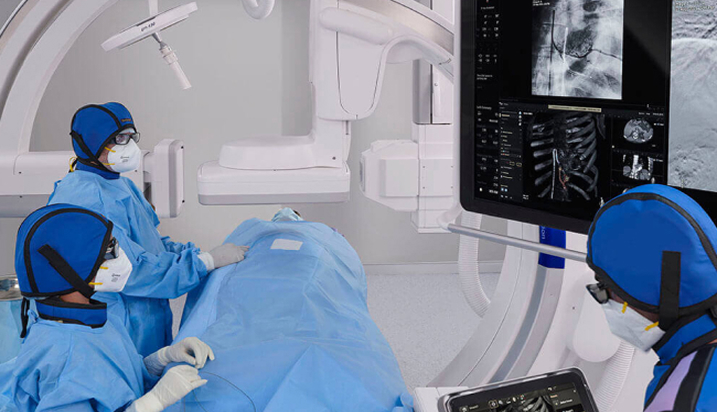Bi-Plane Cath Lab
The Bi-Plane Cath Lab at Burjeel Medical City is equipped with cutting-edge imaging technology designed to enhance the precision of diagnostic and therapeutic procedures, particularly for cardiovascular, neurovascular, and complex vascular cases. The bi-plane imaging system uses two X-ray sources and detectors simultaneously, providing highly detailed, real-time 3D images from two different angles. This advanced imaging capability is essential for the accurate diagnosis and treatment of complex conditions, including those affecting the heart, brain, and vascular systems.
Key Features.
The Bi-Plane Cath Lab offers numerous advanced features that improve procedural accuracy and patient safety:
Comprehensive
Visualization
The Bi-Plane Cath Lab provides comprehensive imaging that supports complex cardiovascular and neurovascular interventions, enabling precise navigation of catheters and other instruments during procedures.
Minimally Invasive
Procedures
The system enables the use of catheters and other minimally invasive techniques, which means fewer incisions and reduced recovery times. It is particularly beneficial for diagnosing and treating complex conditions without the need for open surgery.
Reduced Radiation
Exposure
The bi-plane system allows for faster procedures and reduces the need for multiple scans, helping to minimize radiation exposure to both patients and staff. This makes it safer for everyone involved.
Real-Time Imaging
The system provides live, high-resolution 3D images during procedures, enabling surgeons to navigate with pinpoint accuracy. This real-time imaging ensures more efficient and effective treatment.
Dual-Plane Imaging
The bi-plane system captures two simultaneous X-ray images from different angles, allowing physicians to visualize complex anatomical structures in great detail. This provides them with a complete view of the patient's condition during the procedure.
Conditions Treated Using the Bi-Plane Cath Lab.
The Bi-Plane Cath Lab is used for various diagnostic and therapeutic procedures, particularly in the treatment of cardiovascular and neurovascular conditions, including:

- Cerebral aneurysms
- Brain tumors affecting blood vessels
- Carotid artery disease
- Arteriovenous malformations (AVMs)
- Stroke (ischemic and hemorrhagic)
- Thrombectomy for acute stroke treatment
- Vascular tumors
- Cardiovascular complications related to cancer
- Coronary artery disease
- Valvular heart disease
- Congenital heart defects
Benefits of the Bi-Plane Cath Lab.
The Bi-Plane Cath Lab offers numerous benefits for both physicians and patients, ensuring optimal treatment precision and patient safety:

Enhanced Precision
The dual-plane imaging system offers highly detailed, real-time views of complex anatomical structures, allowing for more precise diagnosis and treatment.
Reduced Procedure Time
By capturing images from two angles simultaneously, the bi-plane system speeds up procedures, reducing the overall time patients spend in the Cath Lab.
Minimally Invasive
Many procedures performed in the Bi-Plane Cath Lab are minimally invasive, resulting in shorter recovery times, less pain, and reduced risk of complications.
Improved Outcomes
The detailed imaging provided by the bi-plane system allows for more accurate and effective treatment, particularly in cases involving delicate structures like the brain or coronary arteries.
Lower Radiation Exposure
The ability to capture multiple images in a single scan reduces the need for repeated X-rays, lowering the patient's radiation exposure.
Our Approach to Cardiovascular and Neuro-Oncology Care.
At Burjeel Medical City, the Bi-Plane Cath Lab plays a key role in our approach to treating complex cardiovascular and neurovascular conditions:

Multidisciplinary Collaboration
Our team of interventional radiologists, neuro-oncologists, cardiologists, and vascular surgeons work together to ensure the most accurate and effective treatment for each patient.
Minimally Invasive Techniques
Whenever possible, we use minimally invasive procedures to diagnose and treat conditions in the Cath Lab, reducing recovery times and improving outcomes.
Real-Time Decision Making
The real-time imaging capabilities of the bi-plane system allow physicians to make immediate decisions during procedures, ensuring the best possible results.
Focus on Safety
We prioritize patient safety by using advanced imaging technologies that minimize radiation exposure and reduce the risk of complications.
Patient Journey.
Patients undergoing procedures in the Bi-Plane Cath Lab at Burjeel Institute can expect a seamless and well-coordinated experience
-

Initial Consultation
A thorough consultation with a cardiologist, neuro-oncologist, or interventional radiologist to assess the patient's condition and determine if a procedure in the Bi-Plane Cath Lab is appropriate.
-

Pre-Procedure Preparation
Patients are given detailed instructions on how to prepare for the procedure, including any necessary pre-operative tests or imaging studies.
-

Bi-Plane Cath Lab Procedure
The procedure is performed in the Cath Lab using real-time imaging to guide the catheter and other instruments, ensuring accurate diagnosis and treatment.
-

Post-Procedure Monitoring
After the procedure, patients are closely monitored in a recovery area, with follow-up imaging or tests performed as needed.
-

Post-Procedure Care
Patients receive personalized post-procedure care, including instructions for recovery and follow-up appointments to monitor their progress.